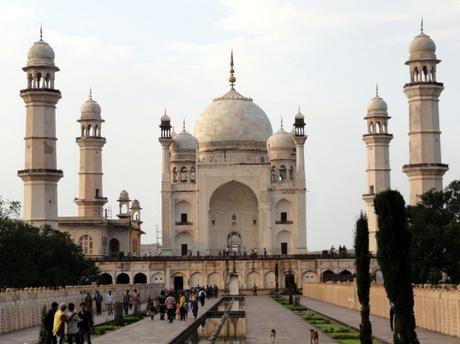Named after the last Mughal king Aurangzeb, the city of Aurangabad is popularly known as the tourism capital of Maharashtra. Located in the Deccan plateau, the city is home to a number of UNESCO World Heritage Sites including the impressive Ajanta and Ellora caves. Known as the ‘city of gates‘, Aurangabad has close to 52 gates, each of which have a local history attached to it. A little over 300 km from Mumbai, the city is a major manufacturing and IT hub and is one of the fastest growing cities not only in India but also Asia. The city has always been a major silk and cotton textile production center due to its location on a major trade route.
While in the city, there is a lot to do in which includes sightseeing, shopping and sampling some of the best Mughlai fare. You can also pick up their exquisite Paithani and Himroo silk weaves, silverware and semi-precious stones. Below are my top four picks while in Aurangabad.
Aurangabad caves:
Arguably one of the best attractions in the city, these are a set of 12 Buddhist caves located just about two kilometers from the Bibi ka Maqbara. Segregated into three groups, these caves are located on top of a small hill and are dated between 3rd century and 7th century AD. The three sets of Buddhist caverns grouped as caves 1-5, 6-9 and 10-12 are famous for their heterogeneous rock formations and attract hordes of travellers every year.

The elaborate sculptural embellishments on the rocks of these caves are testimony of our rich heritage and culture, and a reflection of the achievements of Indian classical art. Cave 3 is the largest which features a huge verandah and the beautiful carving of the Buddhist shrine ‘Sutasoma Jataka‘. Cave 7 is also extremely significant with its elaborate sculptures and carvings. It has a central shrine with an outer corridor running all around. Other than these, the statues and carvings of Buddha, Indian dieties and intricate sculptural panels here make it an important destination for avid history lovers and researchers as well. The hill provides a picturesque view of the whole city including its famous monument; Bibi ka Maqbara.

Bibi ka Maqbara:
Built in the 1678, by Azam Shah, the son of Mughal emperor Aurangzeb , this mausoleum is the principal monument in the city. Literally translating into ‘Tomb of the Lady‘, this fabulous structure is dedicated to Aurangzeb’s wife, Dilras Banu Begum. With its striking resemblance to the Taj Mahal, this monument is also known as the Dakkhani Taj or Taj of the Deccan.


The architecture is characteristically Mughal with the monument being in the center of the ‘Charbagh’ or a Persian style of garden layout. The walk from the entrance to the monument is lined by lush green lawns, fountains and well maintained gardens. The mausoleum itself has four minarets and stands on an elevated square platform with an onion dome on top. An architectural wonder, the monument is resplendent with elaborate carvings and magnificent motifs. The decoration of the tomb per se is simple and moderate. While it is often referred to as the “poor man’s Taj”, Bibi ka Maqbara has its own distinct splendor and grace giving it a unique personality which makes it a “must-visit”.

Panchakki:
Also known as the water mill, the name Panchakki is derived from the mill which was used to grind grain for pilgrims. Located in the heart of the city, this attraction is a typical example of medieval engineering which was built in 1744 AD. In fact, the complex of Panchakki was once the abode of the great Sufi saints who came to India around the 12th century. It was the residence of the popular saint “Baba Shah Musafir”.

The Panchakki with its own elaborate underground channel was ingeniously designed to use the energy generated by the flowing water from a nearby spring to turn the large grinding stones of the flour mill. The ground grain was used for pilgrims, disciples of saints and the troops of the garrison. Water, till date is carried by clay pipes from the source which is about six kilometers away at the north of the city. The water is made to flow into a huge elevated masonry pillar from where it empties down into the main tank.
Paithani and Himroo Fabric Shopping:
While you’re in Aurangabad, do venture out for some unique Paithani and Himroo silk weaves shopping. Named after the Paithan town in the state, Paithani is an extremely fine, hand woven silk. Characterized by oblique pattern borders and peacock motifs on the ‘pallus’ aka ends, these sarees are considered amongst the richest in the state. Classified by three criteria: motifs, weaving and colours, Paithani is the carrier of a legacy of over 2000 years. Exclusively handmade, it takes an artisan anywhere between a month and two years to weave a saree, depending on its level of design and detailing. Equally famous is the Himroo fabric which is a blend of silk and cotton, grown locally in Aurangabad.

In demand due to its rich heritage, Himroo is characterized by the use of Persian designs. The Himroo Art Gallery in the city center is a great place to view and experience this ancient tradition that is being preserved till today. You can see craftsmen working on the manual weaving machines of the yesteryears and can also choose to shop from the wide range of shawls, fabrics and sarees available.

This article was originally published in Happy trips; click here to read the full article. For top attractions in other cities, do read my posts here and here.
